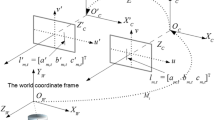Abstract
We propose a novel minimal solver for recovering camera motion across two views of a calibrated stereo rig. The algorithm can handle any assorted combination of point and line features across the four images and facilitates a visual odometry pipeline that is enhanced by well-localized and reliably-tracked line features while retaining the well-known advantages of point features. The mathematical framework of our method is based on trifocal tensor geometry and a quaternion representation of rotation matrices. A simple polynomial system is developed from which camera motion parameters may be extracted more robustly in the presence of severe noise, as compared to the conventionally employed direct linear/subspace solutions. This is demonstrated with extensive experiments and comparisons against the 3-point and line-sfm algorithms.
Similar content being viewed by others
References
Ansar, A., & Daniilidis, K. (2003). Linear pose estimation from points or lines. IEEE Transactions on Pattern Analysis and Machine Intelligence, 25(5), 578–589.
Bartoli, A., & Sturm, P. (2003). Multiple-view structure and motion from line correspondences. In ICCV.
Bujnak, M., Kukelova, Z., & Pajdla, T. (2008). A general solution to the p4p problem for camera with unknown focal length. In IEEE computer society conference on computer vision and pattern recognition (CVPR) (pp. 1–8).
Chandraker, M., Lim, J., & Kreigman, D. J. (2009). Moving in stereo: efficient structure and motion using lines. In ICCV.
Christy, S., & Horaud, R. (1999). Iterative pose computation from line correspondences. Computer Vision and Image Understanding, 73(1), 137–144.
Comport, A., Malis, E., & Rives, P. (2007). Accurate quadrifocal tracking for robust 3d visual odometry. In ICRA (pp. 40–45).
Dornaika, F., & Garcia, C. (1999). Pose estimation using point and line correspondences. Real-Time Imaging, 5(3), 215–230.
Fischler, M. A., & Bolles, R. C. (1997). Random sample consensus: a paradigm for model fitting with applications to image analysis and automated cartography. International Journal of Computer Vision, 22(2), 125–140.
Haralick, R., Lee, C., Ottenberg, K., & Nolle, M. (1991). Analysis and solutions of the three point perspective pose estimation problem. In IEEE computer society conference on computer vision and pattern recognition (CVPR).
Hartley, R. (1997). Lines and points in three views and the trifocal tensor. International Journal of Computer Vision, 22, 125–140.
Hartley, R. (1998). Computation of the trifocal tensor. In ECCV (pp. 20–35).
Hartley, R. I., & Zisserman, A. (2000). Multiple view geometry in computer vision. Cambridge: Cambridge University Press, ISBN:0521623049.
Heyden, A. (1995). Geometry and algebra of multiple projective transformations. PhD thesis, Lund University.
Horn, B. K. P. (1987). Closed-form solution of absolute orientation using unit quaternions. Journal of the Optical Society of America, 4, 629–642.
Kukelova, Z., Bujnak, M., & Pajdla, T. (2008). Automatic generator of minimal problem solvers. In ECCV (pp. 302–315).
Kukelova, Z., Bujnak, M., & Pajdla, T. (2008). Polynomial eigenvalue solutions to the 5-pt and 6-pt relative pose problems. In BMVC.
Li, H., & Hartley, R. (2006). Five-point motion estimation made easy. In ICPR (Vol. 2)
Liu, Y., & Huang, T. (1988). A linear algorithm for motion estimation using straight line correspondences. In ICPR (pp. 213–219).
Lowe, D. (1999). Object recognition from local scale-invariant features. In Proceedings of the international conference on computer vision (pp. 1150–1157).
Lucas, B. D., & Kanade, T. (1981). An iterative image registration technique with an application to stereo vision. In International joint conferences on oratorical intelligence (IJCAI) (pp. 1151–1156).
Neira, J., Tardos, J. D., Horn, J., & Schmidt, G. (1999). Fusing range and intensity images for mobile robot localization. IEEE Transactions on Robotics and Automation, 15, 76–84.
Nister, D. (2004). An efficient solution to the five-point relative pose problem. IEEE Transactions on Pattern Analysis and Machine Intelligence, 26(6), 756–770.
Nister, D., Naroditsky, O., & Bergen, J. (2004). Visual odometry. In IEEE computer society conference on computer vision and pattern recognition (CVPR) (Vol. 1, pp. 652–659).
Oliensis, J., & Werman, M. (2000). Structure from motion using points, lines, and intensities. In IEEE computer society conference on computer vision and pattern recognition (CVPR) (Vol. 2).
Pollefeys, M., Nister, D., & et al. (2007). Detailed real-time urban 3d reconstruction from video. In IJCV.
Pradeep, V., & Lim, J. (2010). Egomotion using assorted features. In IEEE computer society conference on computer vision and pattern recognition (CVPR) (pp. 1514–1521).
Rosten, E., & Drummond, T. (2005). Fusing points and lines for high performance tracking. In ICCV (Vol. 2, pp. 1508–1515).
Seitz, S., & Anandan, P. (1999). Implicit representation and scene reconstruction from probability density functions. In IEEE Computer Society Conference on Computer Vision and Pattern Recognition (CVPR) (Vol. 2).
Shashua, A., & Wolf, L. (2000). On the structure and properties of the quadrifocal tensor. In Lecture notes in computer science (pp. 710–724).
Stewénius, H., Engels, C., & Nister, D. (2006). Recent developments on direct relative orientation. Journal of Photogrammetry and Remote Sensing, 60, 284–294.
Torr, P. H. S., & Zisserman, A. (1997). Robust parameterization and computation of the trifocal tensor. Image and Vision Computing, 15, 591–605.
Triggs, B. (1999). Camera pose and calibration from 4 or 5 known 3d points. In ICCV (pp. 278–284).
von Gioi, R. G., Jakubowicz, J., Morel, J.-M., & Randall, G. (2010). Lsd: a fast line segment detector with a false detection control. IEEE Transactions on Pattern Analysis and Machine Intelligence, 32, 722–732.
Zhang, Z. (1998). Determining the epipolar geometry and its uncertainty: a review. International Journal of Computer Vision, 27, 161–195.
Zhu, Z., Oskiper, T., Samarasekera, S., Kumar, R., & Sawhney, H. S. (2007). Ten-fold improvement in visual odometry using landmark matching. In International conference on computer vision (ICCV) (pp. 1–8).
Author information
Authors and Affiliations
Corresponding author
Rights and permissions
About this article
Cite this article
Pradeep, V., Lim, J. Egomotion Estimation Using Assorted Features. Int J Comput Vis 98, 202–216 (2012). https://doi.org/10.1007/s11263-011-0504-5
Received:
Accepted:
Published:
Issue Date:
DOI: https://doi.org/10.1007/s11263-011-0504-5




